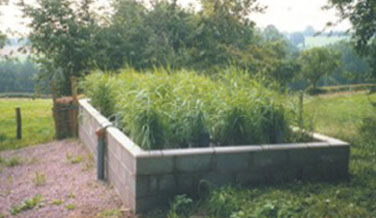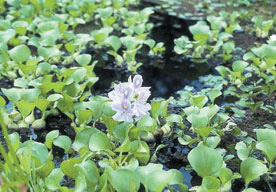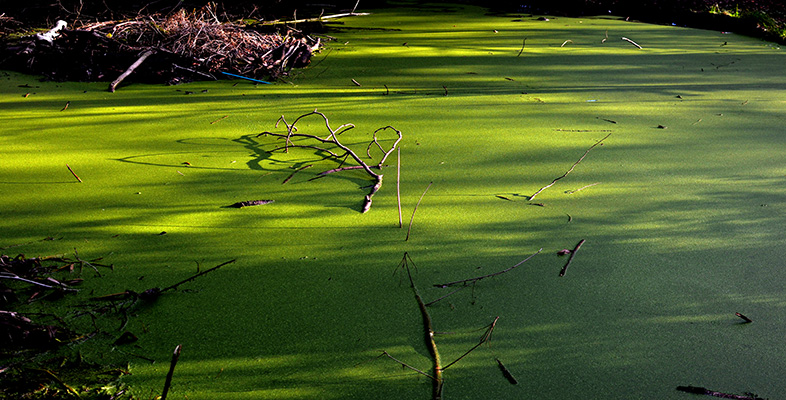4.3 Reducing the nutrient source, continued
4.3.4 Wetlands
Wetlands can be used in a similar way to buffer strips as a pollution control mechanism. They often present a relatively cost-effective and practical option for treatment, particularly in environmentally sensitive areas where large waste-water treatment plants are not acceptable. For example, Lake Manzala in Egypt has been suffering from severe pollution problems for several years. This lake is located on the northeastern edge of the Nile Delta, between Damietta and Port Said. Land reclamation projects have reduced the size of the lake from an estimated 1698 km2 to 770 km2. The lake is shallow, with an average depth of around 1.3 m.
Five major surface water drains discharge polluted waters into the lake. These waters contain municipal, industrial and agricultural pollutants, which are causing water quality to deteriorate and fish stocks to decline. Recently, efforts have been made to improve water quality in the most polluted of the five drains. This carries waste water from numerous sources, including sewage effluent from Cairo, waste water from industries, agricultural discharges from farms, and discharges and spills from boat traffic. Several methods for drain water treatment have been proposed, including conventional waste-water treatment plants and other chemical and mechanical methods for aerating the drain water. There are also proposals for construction of a wetland to treat approximately 25 000 m3 per day of drain water and discharge the treated effluent back to the drain.
The treatment process involves passing the drain water through basins and ponds, designed to have specific retention times. The pumped water first passes through sedimentation basins to allow suspended solids to settle out (primary treatment), followed by a number of wetland ponds (secondary treatment). The ponds are cultivated with different types of aquatic plants, such as emergent macrophytes (e.g. Phragmites) with well-developed aerenchyma systems to oxygenate the rhizosphere, allowing the oxidation of ammonium ions to nitrate. Subsequent denitrification removes the nitrogen to the atmosphere.
The waste-water treatment mechanism depends on a wide diversity of highly productive organisms, which produce the biological activity required for treatment. These include decomposers (bacteria and fungi), which break down particulate and dissolved organic material into carbon dioxide and water, and aquatic plants. Some of the latter are able to convey atmospheric oxygen to submerged roots and stems, and some of this oxygen is available to microbial decomposers. Aquatic plants also sequester nitrogen and phosphorus. Species such as common reed (Phragmites australis, Figure 4.5) yield a large quantity of biomass, which has a range of commercial uses in the region. Another highly productive species is the water hyacinth (Eichhornia crassipes, Figure 4.6). This species is regarded as a serious weed on the lake and is regularly harvested to reduce eutrophication. However, it has a potential role in water treatment due to its high productivity and rapid rates of growth. The resultant biomass could possibly be harvested and used for the production of nutrient-rich animal feed, or for composting and the production of fertilizer. Further research is required to develop practical options.


The passage of water through emergent plants reduces turbidity because the large surface area of stems and leaves acts as a filter for particulate matter. Transmission of light through the water column is improved, enhancing photosynthesis in attached algae. These contribute further to nutrient reduction in through-flowing water. The mixture of floating plants and emergent macrophytes contributes to removal of suspended solids, improved light penetration, increased photosynthesis and the removal of toxic chemicals and heavy metals.
Estimates for the removal of total suspended solids (TSS), biological oxygen demand (BOD), total phosphorus and total nitrogen by the different wetland components are provided in Table 4.2. These suggest that wetlands, combined with sedimentation and ancillary water treatment systems, could play an important part in reducing nutrient loadings.
| Parameter | Sedimentation pond | Wetland treatment system | ||||
|---|---|---|---|---|---|---|
| influent conc./mg l−1 | effluent conc./mg l−1 | removal efficiency/% | influent conc./mg l−1 | effluent conc./mg l−1 | removal efficiency/% | |
| TSS | 160 | 32 | 80 | 32 | 6.4 | 80 |
| BOD | 40 | 24 | 40 | 24 | 18.0 | 25 |
| total P | 5 | 4 | 20 | 4 | 3.2 | 20 |
| total N | 12 | 12 | 0 | 12 | 8.4 | 30 |
| organic N | 4 | 4 | 0 | 4 | 3.8 | 5 |
| ammonium N | 5 | 5 | 0 | 5 | 3.9 | 22 |
